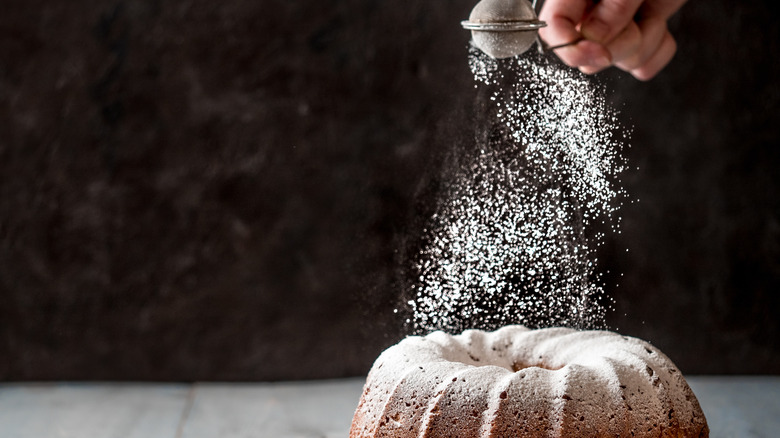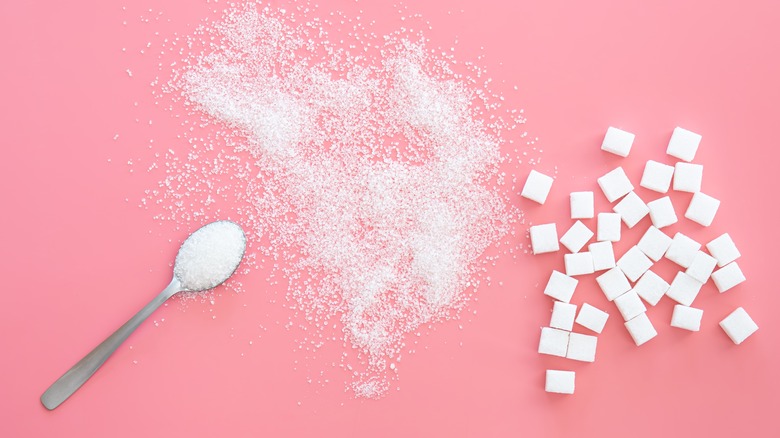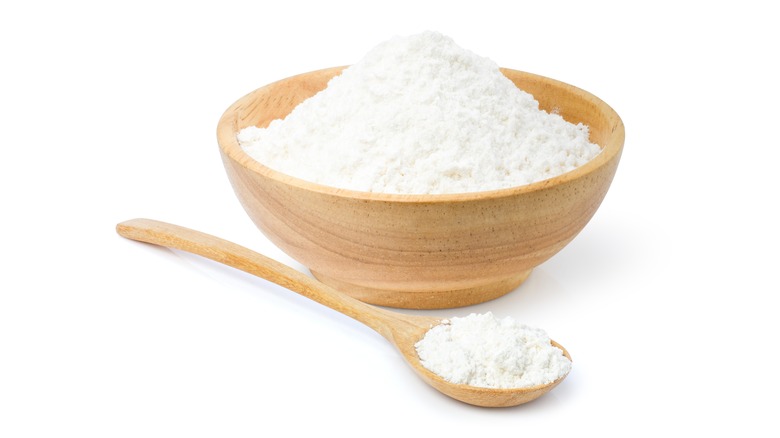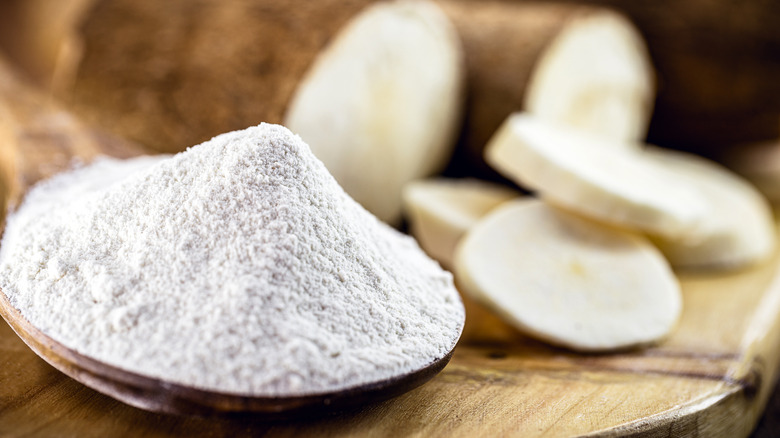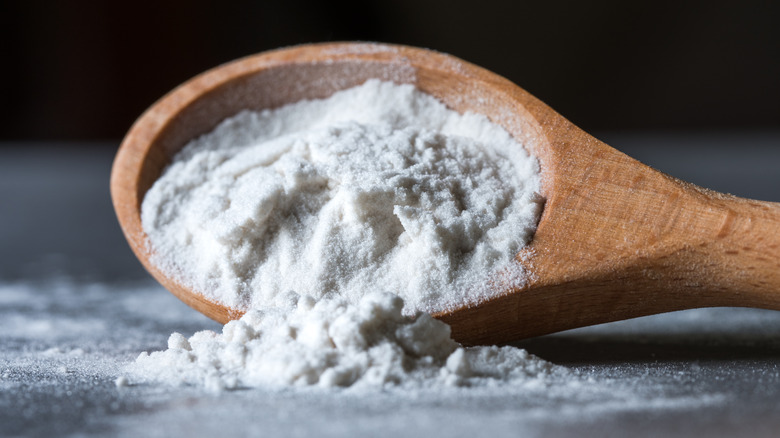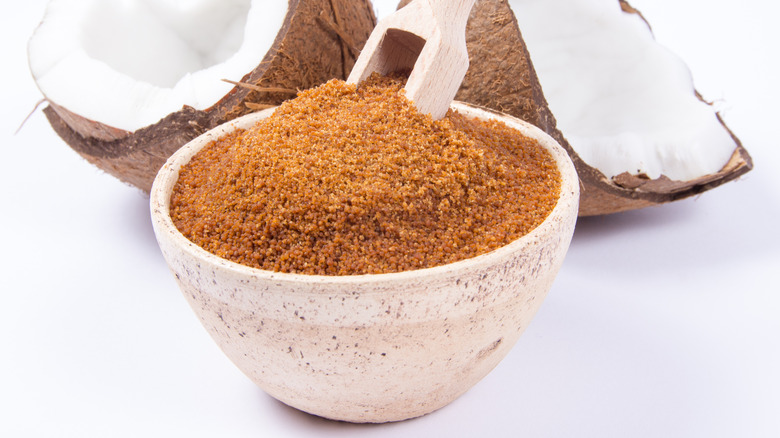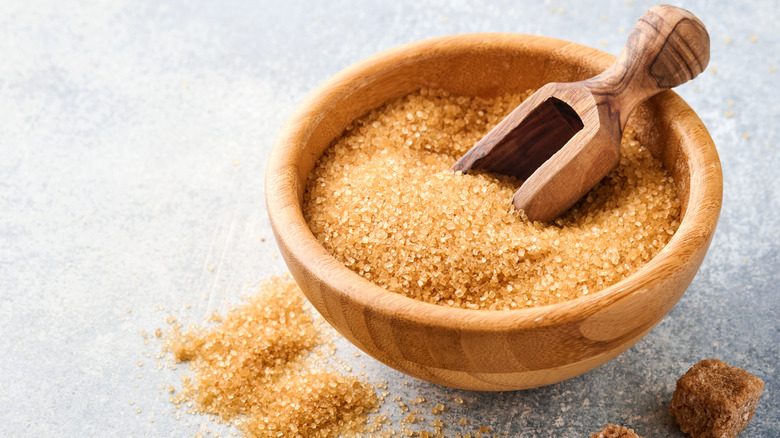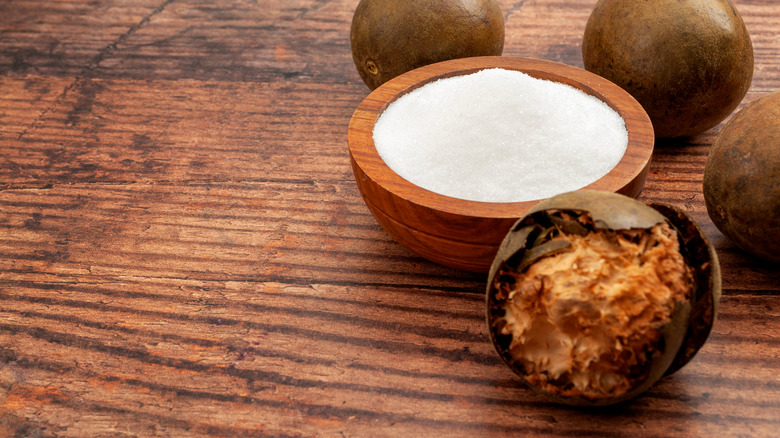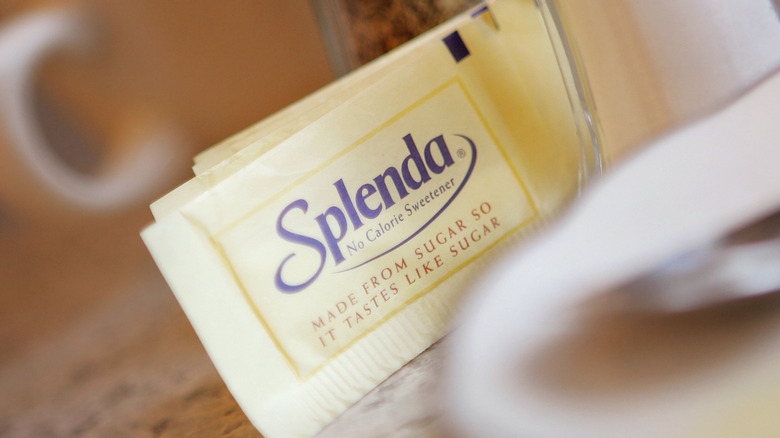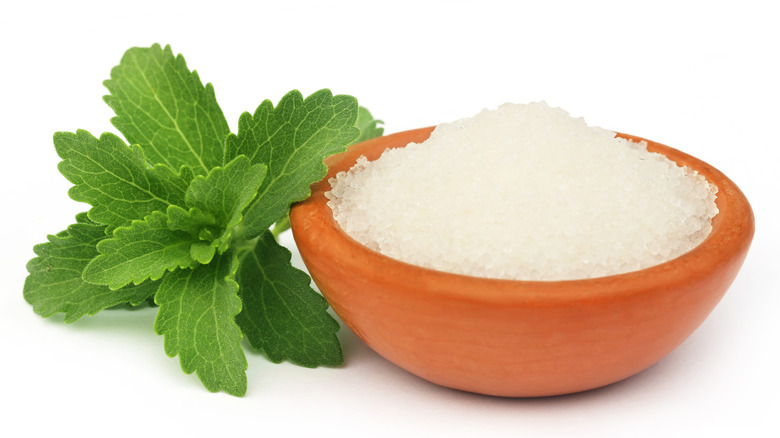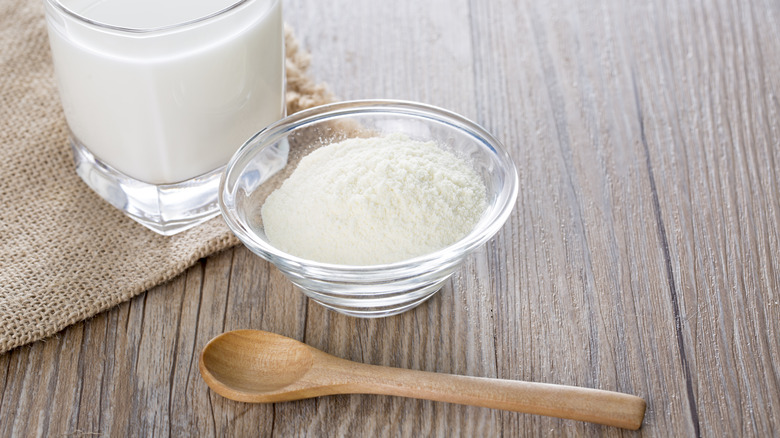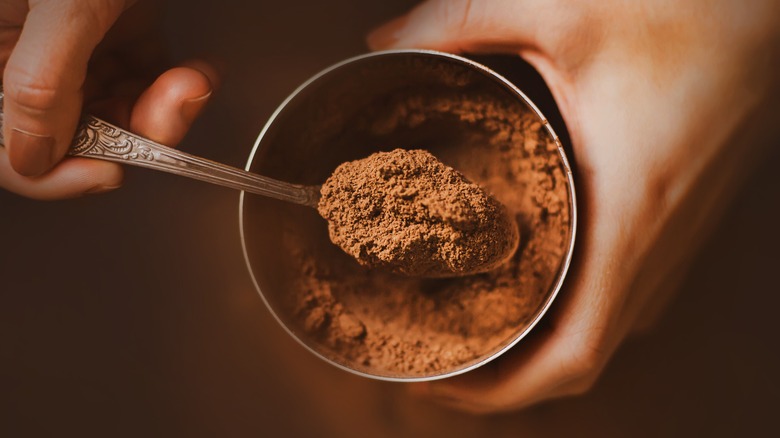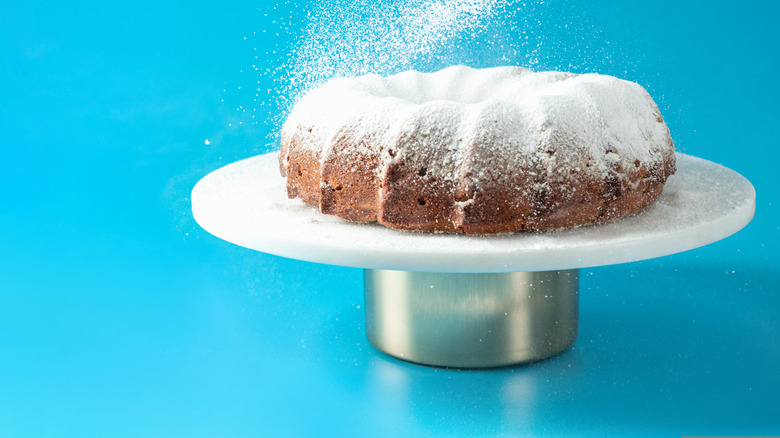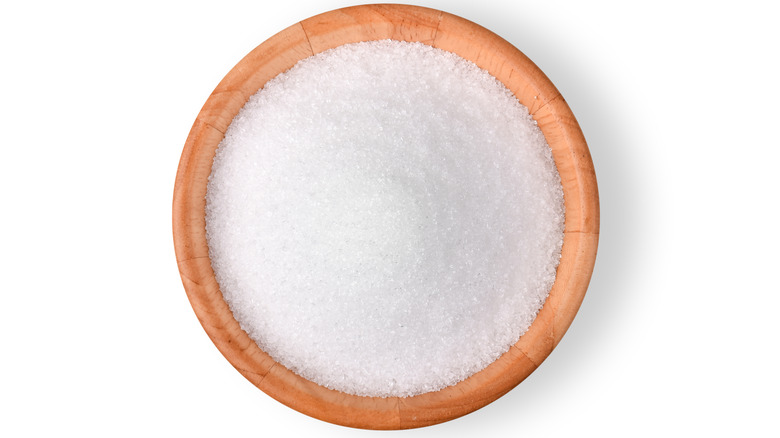13 Substitutes You Can Use For Powdered Sugar
POV: You're midway through making a batch of cream cheese icing or jelly doughnut holes and realize you're out of powdered sugar. What do you do?
Powdered sugar, also called confectioner's sugar or 10X, is a superfine form of cane sugar made by pulverizing granulated sugar into a very fine powder and adding a bit of starch to keep it from caking and clumping. Its powdery texture makes it perfect for adding pizzazz to a flourless chocolate cake or a little bit of extra sweetness to lemon bars or Italian wedding cookies. And it's a necessary ingredient in many frosting, icing, and glaze recipes due to its ability to seamlessly dissolve into butter or milk, which is why it's dubbed "icing sugar" in the United Kingdom.
While the store-bought stuff is obviously ideal, there are many worthy ways to mimic the flavor and texture of powdered sugar at home. And you may have them tucked away in your pantry without even knowing it.
Keep reading for 13 effective substitutes for powdered sugar, including some sugar-free options in case you're looking for a calorie-free or keto-friendly alternative. You'll be back to making cupcakes in no time.
1. Granulated sugar and cornstarch
The easiest and most effective substitute for powdered sugar is a combination of granulated sugar and cornstarch, as these are the two ingredients that make up most store-bought powdered sugar anyway.
To make this substitute at home, combine 1 tablespoon of cornstarch with 1 cup of powdered sugar and add it to a high-speed blender (like a Nutribullet or Vitamix), blending until very fine and powdery. Be patient! It may take several minutes to achieve the chalky texture you're looking for. If you don't have a high-powered blender, a spice grinder or coffee grinder can do well in a pinch. But keep in mind that it may be quite time-consuming and messy due to their small size.
Once you've achieved a powdery texture, sift it with a fine sieve if you see any clumps or large granules. While you're unlikely to achieve quite the same powdery texture you'll find at the store, you can get pretty close. And you can feel free to use your homemade powdered sugar in nearly any recipe — though extra-sensitive recipes like French macarons are usually best with the store-bought stuff.
2. Granulated sugar and potato starch
If you don't have cornstarch on hand, you can use a combination of granulated sugar and potato starch instead. Potato starch is made by extracting the starch from, you guessed it, potatoes. Freshly-harvested potatoes are crushed to separate the starch from other cells, and then the starch is rinsed and dried into a fine white powder.
Like cornstarch, potato starch works as an anti-caking agent and thickener and can be used in similar ways. And because it's virtually tasteless, it won't change the flavor of your favorite recipes. Plus, it's (obviously) corn-free, so it's a great option for anyone with corn allergies or those looking to stay Kosher for Passover.
To use it as a powdered sugar substitute, simply combine 1 tablespoon potato starch for every cup of powdered sugar, then blend in a high-speed blender or coffee grinder until very fine and powdery. This substitute can be used for everything from dusting cakes to making buttercream, icing, and glazes.
3. Granulated sugar and tapioca starch
Tapioca starch is another excellent option for making powdered sugar at home. In fact, store-bought, organic powdered sugar often contains tapioca starch in lieu of cornstarch because the cornstarch often doesn't meet organic standards.
This popular starch is made by extracting the starch from cassava root (also known as yucca), a tuber native to South America and a common food in countries across Africa, Asia, and South America. The cassava root is crushed to release starchy liquid; once the water is evaporated, you're left with a powdery starch that works similarly to cornstarch or potato starch. Because tapioca starch granules are smooth and round, powdered sugar made with it is particularly good for making creamy, smooth icings and glazes. But because tapioca absorbs liquid more quickly than other starches, it may struggle when dusted over moist desserts like lemon bars.
To make it at home, you'll use the same ratios. Combine 1 tablespoon of tapioca starch with 1 cup of granulated sugar and blend on high until you achieve a very fine and powdery texture.
4. Granulated sugar and arrowroot powder
If you happen to have some arrowroot powder lying around, you can use it in the exact same way as cornstarch, potato starch, and tapioca starch by blending it with granulated sugar to create a good substitute for powedered sugar. Arrowroot starch is made from the rhizomes — or underground stems — of the Maranta arundinacea plant, a perennial herb native to rainforests around the world. According to "Starch (Third Edition)" via Science Direct, it's famously easy to digest, making it a great option for those with sensitive stomachs.
This white, flavorless starch is traditionally used as a remedy for digestive disorders as well as a thickener for puddings, jellies, and pies — and it happens to be a great anti-caking agent for homemade powdered sugar as well. Simply combine 1 tablespoon of arrowroot starch with 1 cup of granulated sugar and blend until very fine. This substitute works well for almost any recipe that calls for powdered sugar.
5. Coconut sugar and starch of your choice
Whether you're out of granulated sugar or you're looking for a less-processed form of powdered sugar, coconut sugar makes a great substitute when combined with popular starches like cornstarch, arrowroot, tapioca, or potato. Coconut sugar comes from the sap of the coconut palm tree and is harvested from coconut blossoms.
The sugar undergoes minimal processing — unlike cane sugar, which is often bleached and refined — which maintains some of the nutrients from the sap and gives it a slight caramel-y flavor and a light brown color. It can be used as a 1:1 swap in most baked goods, including homemade powdered sugar. Just keep in mind that it will taste slightly different from standard powdered sugar, which can actually be quite pleasant depending on the recipe. Its slight tropical flavor makes it particularly good for dusting over banana pancakes. To make it into powdered sugar, combine 1 cup of granulated coconut sugar with 1 tablespoon of the starch of your choice — then blend on high until fine and powdery.
6. Turbinado sugar and starch of your choice
Raw turbinado sugar — a type of minimally processed version of cane sugar — can be used as a powdered sugar substitute when combined with one of the popular starches. Minimal processing means turbinado sugar maintains a small amount of the natural molasses in sugarcane, giving it a light brown color and a subtle caramel flavor that's slightly different from white sugar. And its large, crunchy crystals are particularly ideal for sprinkling over banana bread or snickerdoodle cookies.
To turn it into powdered sugar, combine 1 cup of turbinado sugar with 1 tablespoon of starch and blend until very fine, sifting out any clumps if necessary. You'll end up with a powdered sugar substitute that's perfect for adding some extra flavor to a doughnut glaze or whipped cream. It's also an ideal substitute for rolling cookies or dusting over bundt cakes, but avoid using this one for any recipes where you don't want the flavor to be affected.
7. Monk fruit sweetener and starch of your choice
If you're looking for a keto-friendly or calorie-free alternative to powdered sugar, use a combination of monk fruit sweetener and a starch, such as potato, corn, tapioca, or arrowroot. Monk fruit sweetener is derived from the monk fruit plant, a gourd-like fruit native to China, which contains chemical compounds known as mogrosides (via Scientific Reports). These mogrosides supply high levels of sweetness without the calories or blood glucose boost associated with cane sugar.
To use it as a powdered sugar substitute, you'll want to combine 1 cup of monk fruit sweetener with 1 tablespoon of starch. Blend until powdery and sift out any chunks if necessary. Because monk fruit sweetener is sweeter than sugar — about 100 to 250 times sweeter — you'll want to use about 75% of the powdered sugar required for your recipe. In other words, you should use ¾ cup powdered monk fruit sweetener for every 1 cup of powdered sugar.
8. Splenda and the starch of your choice
Much like monk fruit sweetener, powdered Splenda can make a great sugar-free substitute for powdered sugar when combined with one of the starches previously mentioned. Splenda is made with a combination of maltodextrin (a white powder made from the starch of corn, potato, or rice) and sucralose, and comes in both powdered and granulated forms. Because it lacks the bitter aftertaste of other artificial sweeteners, it's a preferred substitute for sugary sweets and treats. And its powdery texture is ideal for sprinkling and dusting over desserts where you might usually use powdered sugar.
To make it an even more effective substitute, blend 1 cup of Splenda with 1 tablespoon of the starch of your choice. Still, this substitute won't perform in the same way as powdered sugar in certain recipes — like macarons, meringues, and icings — so it's best to stick to dusting cakes or rolling cookies. And because Splenda is significantly sweeter than sugar, you'll want to use about half the amount that's called for in any given recipe, e.g. 1 tablespoon of powdered Splenda for 2 tablespoons of powdered sugar.
9. Stevia and the starch of your choice
This common coffee sweetener makes another decent powdered sugar substitute when ground and combined with a little bit of starch. Free of both calories and carbohydrates, Stevia is an excellent option for those looking to cut down on carbs or control their blood sugar.
According to Healthline, stevia is naturally derived from the leaves of the stevia plant; the leaves are harvested, dried, and steeped in hot water to extract the glycosides — the chemical compounds that give stevia its sweetness. Stevia is sold in many different forms, but it's best to use its powdered or dried forms when you're substituting powdered sugar. For best results, combine 1 cup of powdered Stevia with 1 tablespoon of starch and blend until very fine.
Like Splenda, Stevia is much sweeter than cane sugar, so you'll need to use a bit less to achieve the same sweetness in any given recipe. For that reason, avoid using this substitute in sensitive recipes like cookies, cakes, and meringues that require an exact amount of powdered sugar and stick to using it for dusting over desserts or supplementing sugar in a batch of buttercream frosting.
10. Dry milk powder
Dry milk powder is a little-known hero when it comes to baking. This pantry staple can be used to add flavor to a myriad of recipes and baked goods, including some that call for powdered sugar.
Milk powder is essentially a highly concentrated, shelf-stable version of milk. Because it contains all of the fat, protein, and flavor of milk, it adds some extra richness and creaminess to all sorts of treats. While it won't add much sweetness, its powdery texture means it can easily be dusted over cookies and cakes, or even added to buttercream frosting to add some bulk without the added sweetness and calories of sugar.
To add a sweet touch, you can also blend dry milk powder with whatever sugar or sweetener you have on hand, like granulated sugar, coconut sugar, or sugar-free sweetener. Use as much or as little sweetener as you wish, but a good place to start is ½ cup sugar or sweetener for every cup of dry milk powder. If you're avoiding dairy, dairy-free milk powder, such as powdered soy milk, almond milk, or coconut milk, works just as well.
11. Cocoa powder
Another surprising substitute for powdered sugar? Cocoa powder! This chocolate powder is made by pulverizing cacao particles after the cocoa butter is extracted from the beans, resulting in a deeply-flavored powder that resembles the texture of powdered sugar. Cocoa powder is commonly dusted over desserts like tiramisu and flourless chocolate cakes, and would make a great substitute for powdered sugar in everything from waffles toppings to rolling Italian wedding cookies — so long as you're looking for a chocolate-y result.
Because cocoa powder is unsweetened, it won't add sweetness to recipes like powdered sugar does. If you're looking for a sweet substitute, blend cocoa powder with granulated sugar or any other sweetener of your choice. Or try using hot cocoa mix, which is typically made with cocoa powder, sugar, and dry milk powder. This substitute is best used for dusting over desserts or flavoring frostings and won't do so well in meringues, icings and glazes as it doesn't contain any cornstarch.
12. Caster sugar
Caster sugar is a lesser-known version of granulated sugar that's commonly used in light and airy recipes like meringues and pavlovas. It's essentially superfine sugar that has been ground into tiny granules that are very nearly the texture of a powder. The small granules dissolve more quickly, which is what makes caster sugar ideal for delicate meringues and souffles or for dissolving into syrups.
When it comes to a powdered sugar substitute, caster sugar is best used sprinkled over desserts like lemon bars and cakes, or added to buttercream frostings, though keep in mind that the texture will be slightly grainier than what you'd get with powdered sugar. And because it doesn't contain any starch, it won't perform the same way that powdered sugar does in recipes like French macarons or glazes, so it's best to avoid this substitute in some instances.
If you happen to have some starch lying around, you can also combine caster sugar with cornstarch, potato starch, tapioca starch, or arrowroot powder for a more comparable substitute. Combine 1 cup of caster sugar with 1 tablespoon of starch and blend until fine.
13. Xylitol
If you're looking for another calorie-free alternative for powdered sugar, then look no further than xylitol. This increasingly-popular sugar substitute has a fine, powdery texture that resembles powdered sugar and is made even more powdery by blending it for a few minutes in a high-speed blender.
Xylitol is a type of sugar alcohol that naturally occurs in some plants, and it looks and tastes very similar to real sugar in its granulated form, but with significantly fewer calories and carbohydrates (40% fewer, according to Healthline).
Although xylitol is designed for being used as a 1:1 substitute in recipes, when it comes to texture, flavor, and browning the exact results will certainly vary. When using xylitol as a powdered sugar substitute, it's best to use it for recipes that don't require powdered sugar as a texturizing agent. We suggest using it for dusting, sprinkling, and rolling in lieu of adding it to frostings, icings, and meringues. And if for any reason you're making something for your pets, keep in mind that xylitol is not safe for both dogs and ferrets and can be lethal if consumed, according to the FDA.
